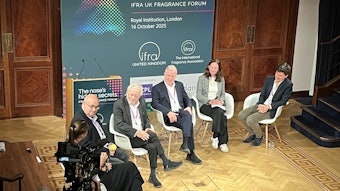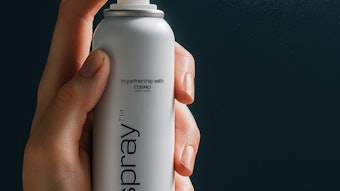
Semiotics, the study of how meanings are formed, usually starts with Ferdinand de Saussure, a Swiss linguist whose famous conception of signs is foundational. Any sign, regardless of field of study, has three main parts: the form used to denote the sign (the signifier); the cognitive meaning to which the sign attaches (the signified); and the referent to which the sign as a whole refers in real life.
We know the associative power of scent is extremely strong, we know its intimate link to memory and emotion, and we know olfactory meanings exist in certain circumstances. From this, it would seem logical that a dependable olfactory language could possibly exist. However, there are two main issues when attempting to construct a coherent olfactory sign system.
First, structuring semiotics in perfumery is outstandingly difficult as we don’t have clear olfactory breaks. The spaces between olfactory qualities and categories are too grey. In music, frequency perception is determined by the ear as to which degrees we can and can’t hear, with the semitone generally accepted as the smallest gradation. But there is no agreed-upon fragmentation and compartmentalization of olfactory experience; all proposed categories such as by chemical, note, material, accord or family have their own problems and too many subsets and overlaps with other categories.
The other big issue revolves around the idea of perfumery language. Languages are built on repetition, association, familiarity and the resultant expectations these factors create, such as the recent integration of the word ‘blockchain’ into Oxford Dictionaries (from the same publisher as The Oxford English Dictionary), or the reattribution of the meaning of ‘basic’ through Instragam-led social practice. It is very rare that olfactory stimuli are presented in situations consistent enough to form absolute consensus over their qualities. People can have different accents but you can still understand the same codes they are drawing on to make sufficiently similar sounds so the takeaway meaning remains in-tact; the ‘accents’ of olfaction are too wide ranging – from the temperature of the room to the wind speed, the other smells around you, the mucus content of your nose, your childhood experiences, your level of health or the combined neuro-signal expression of receptors in the nose. Even if we interrogate fairly ‘easy’ themes such as cleanliness, nature or mundanity, a soap, for example, might smell of jasmine but it could be rose instead; different flowers smell unique; even different roses smell markedly different to create confusion over what the essence of a rose really is, at different concentrations, within different applications, smelled at different times in our lives. The word blockchain may develop in the years to come but it will always remain the word blockchain whether read in winter or summer, in Brazil or Alaska, at night or first thing in the morning.
The Paradox of Perfume
I want to suggest a further reason as to why sign systems and complex concepts are so hard to form in perfumery. Sign systems work because they are impersonal and austere to their referents. A real tree has nothing to do with the word tree. The signifier, signified, and referent are siloed but stand in for each other by proxy or metaphor. When these relationships are complicated as they often are in the arts then something weird happens on a theoretical level that impacts experience and understanding and usually means the true meaning of the work tends towards abstraction.
Related: Perfumery’s Limits: Where is Niche Headed?
Consider what happens when a painter applies paint on a canvas with the sole intention of showing the painterly qualities of the paint and how paint performs under different circumstances. Or when a sculptor uses clay to mold a form that has no reference to our real-life visual world, does not represent an object nor figure, and has no theme other than to show the clayness of clay. Clay itself is the theme of the artwork. Under these conditions, to continue the example, the signifier (the clay) is also the same as the signified (which is clay) brought into fruition by the material (clay again) meaning the sign system is closed and collapses in on itself, assuming a loop of reflexivity that obscures the detection of explicit meaning and forces the artwork into abstract territories.
Meaning then resides in pure subjectivity and the baggage you bring to the work. In much the same way, perfumery sign systems are almost always closed in the sense that we are using materials to represent their materiality, which may explain why we haven’t yet invented an olfactory language that can convey complex concepts.
The Future of Scent Culture
Is there a way we can overcome this paradox and create an agreed-upon olfactory language? I offer seven suggestions as to how to craft more meaningful perfumery and where niche will be in the future, with some quoted ideas from others in the industry. Niche brands of the future should:
- Go to extremes – and specialize to an extreme degree in particular accords, notes or concepts and own that olfactory space. If you’re a specialist leather scent brand then make sure you have access to all leather oils on the market, open a free-standing store inspired by the history of leather with exhibitions, workshops, and masterclasses exploring the faculties of the leather accord in scent and parallels in wine and cigars. Perfumer Antoine Lie thinks that “the salute of real niche business will come from a more luxury approach with innovative and higher qualitative propositions in terms of ingredients or technology. And it won’t be for everybody.”
- Enhance with destination environments and contexts – using crossmodal research about how to make sweet taste sweeter and sex seem sexier. In accordance, vice president of creation and design, branding and marketing fragrances at IFF Judith Gross considers that "for consumers to walk into a perfumery store, niche brands will need to offer an intense experience which the online experience will not be able to compete with.”
- I do not believe there will ever be an objective formulation for scent perception, so celebrate subjectivity and playfulness - move away from naturality back into the fantasy dynamics and the mysterious allure that originally won over the hearts and minds of niche consumers. Niche legend Silvio Levi, co-founder of Calé / Esxence / and Nose, believes that “we have a really rosy future ahead of us, as long as the sector retains that pinch of folly that a creative field like ours cannot do without.”
- Encourage specificity not just in terms of blends but also in terms of identity and explanation, analysis, and manifesto - perfumers should be able to dissect their compositions and explain the intended affects both from an olfactory standpoint but also socially; what cultural touch points, connotations, and values they are underlining or subverting. With the same spirit, Saskia Wilson-Brown, founder of The Institute for Art and Olfaction, commented,
"I think that niche and artisanal perfumery will become increasingly heterogeneous, playing to the fractured subcultures to be found on the internet - much like independent movies have. Moreover, I sense that it will move away from the traditional forms of perfume; grow weirder and weirder, in other words, in order to hone in on more specific tastes."
- Renovate perfumer intake and school acceptance criteria – most of the perfumery schools of today look for a generic mold that combines a blank canvas with a science background, a love of flowers, and a faint creative quirk in their applicants with very few non-traditional profiles. As a result, young perfumers come out with no agenda, no sense of purpose, and little chance of truly innovating. I agree with the following statement from perfumer Christophe Laudamiel:
“Where are the Spielbergs … the Elon Musks … and the Harvards of the perfume industry? [Innovation will come] from new ways of teaching perfumery and from reckless students, artists, designers and engineers.”
- DIY perfumery and self-teaching is the new opportunity of the coming decade – and will likely be integrated eventually into the mainstream through collaboration. With stereotypical enthusiasm, Felix Mayr-Harting from Givaudan declares,
“I envision a future where artisanal perfumery brands and independent perfumers combined with the new possibilities of online commerce to develop a hugely exciting and vibrant set of new business models, new approaches to perfumery, and new engagement of consumers. It’s going to be great!”
- And finally, I believe we should cultivate expert storytelling – by nurturing fragrance expertise and dedicated fragrance teams within the brands, not just at the houses. This does not happen right now; most of the fragrance brand cohort is taken from make-up and is clustered around marketing, sales, and development. In order to disrupt, you need to know your history. IFF’s Juliette Karagueuzoglou proposes that,
“After the explosion and acquisition of niche brands over the last 10 years, the cards are being redistributed. [For brands to survive] they will have to be qualitative, aspirational, and disruptive … tell real stories, and bring to their consumers a new and precious sensory experience.”
To conclude, I do not believe there will ever be a dramatic watershed moment when perfumery suddenly becomes hyper-meaningful. But the development of niche into its next stage will likely involve more specific fragrances for more specific moments of our lives; more choice based on greater knowledge of perfumery processes; and the chance that in 30 years, the fragrance landscape will ripen enough for a rogue perfumer to create a scent that makes smellers instantly feel, understand, and cry over the historical struggles and outstanding achievements in a movement like feminism, cementing a future olfactory language that can only come about through discussion, investigation and collaboration.











